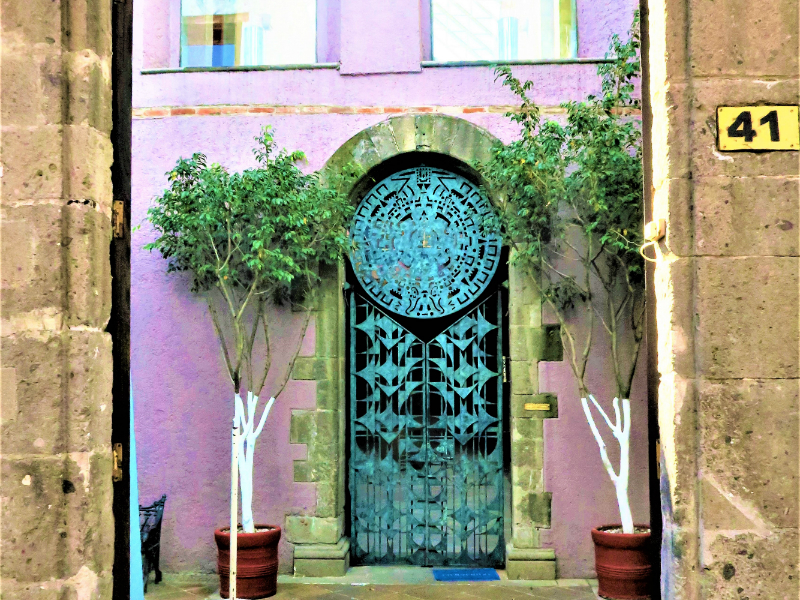A stroll through “500 years of Jewish Mexico City” sounded a little challenging at first. But here we are, on a sunny afternoon, awed by the beautifully restored 1930s Ashkenazic synagogue called Nidjei Israel, which was once the jewel in the crown of a Mexican-Jewish community with roots in the Baltics and eastern Europe.
This architectural wonder opens a door into Mexico’s Jewish history. Giant photos of weddings and other events that have been celebrated within these walls grace the ground floor, the ceiling glows with colourful designs and the ladies’ gallery hosts travelling exhibits.
After the Ashkenazim found new homes in the suburbs, settling in the city’s north and west, this shul fell into disrepair. Then, in 2009, a meticulous restoration spearheaded by the local Jewish community revealed the newly named Historic Synagogue in all its splendour. Today it functions as a community centre that’s open to all and forms “a cultural bridge between Catholic and Jewish Mexicans,” says our guide, Carlos Sanchez. A wide variety of cultural events are held here, including the occasional holiday service.
Besides its sparkling beauty, the Historic Synagogue makes a powerful statement in a country where, for centuries, Judaism could only be practised in utmost secrecy.

Our next stop, Santo Domingo Square, takes us back several centuries to the Spanish Inquisition. When Hernán Cortés invaded in 1519, some Spanish Jews – a few practising in the open, but others hiding their faith – were among his conquistadors (a Jew is said to have built Cortés’ ships). Some Spanish and Portuguese Jews prospered in the new world, until the Inquisition established its Mexican branch. Its much-feared headquarters, which faces the square, now serves as a museum.
Gazing toward a palace once dedicated to torture, forced confessions, public humiliation and burnings at the stake is difficult, even today. Those Jews who eluded the Inquisition turned to peripatetic lives as travelling traders, according to Sanchez. Pointing across to the hostel where they’d stay while selling their wares, he reminds us that Mexico City was at the heart of Spanish trade, right up until the empire collapsed.
Not until the leadership of indigenous lawyer Benito Juarez (1806-1872) did the Mexican government separate church and state, placing Mexico on a progressive path. Yet the Mexican Inquisition, and the approximately 324 Jews who were apprehended as a result, have not been forgotten. We’re shown a public bench, which an artist has adorned with grotesque clown-dogs. These animals deliberately mock the Dominican Order, who are widely disparaged for their role as “dogs,” or Inquisition enforcers.
Leaving Santo Domingo Square and its solemn reminders of the past, Sanchez leads us along the downtown streets that locals still refer to by their colonial-era names – Fabric Street, Jewellery Street – where we peer into store windows filled with ball gowns and fanciful jewels. The Jewish-owned businesses are distinguished by mezuzahs in their doorways.
Like all good guides, Sanchez concludes with a story: In 1938, as anti-fascists fled Francoist Spain, joining the flood of Jews and others who were fleeing Nazism, Mexico’s consul general in Paris, Gilberto Bosques Saldívar, was directed by his government to provide visas to refugees wanting to immigrate to Mexico. So Saldívar moved his embassy from Paris to Marseilles in Vichy France, where he rented two castles to house homeless refugees and declared both to be Mexican territory.
For issuing 40,000 visas to those leaving via the port of Marseilles, Saldívar, his family and staff were arrested by the Gestapo and imprisoned, until Mexico could arrange a prisoner exchange a year later. After his release, he returned home to a massive celebratory parade. Today, Saldívar is honoured at Yad Vashem for rescuing approximately 36,000 Jews, at a time when so many countries had closed their borders to those fleeing fascist terror.
There is now a street in Vienna named for the “Mexican Schindler,” as Sanchez calls this career diplomat and veteran of the Mexican revolution. Yet his story was largely overlooked until the release of the 2010 documentary Visa to Paradise, which was written and directed by Mexican Lillian Lieberman.
In the morning, we pay a visit to the Mexico-Israel Cultural Institute. Tasteful in its design – which echoes the lines of the18th-century house that once stood here – the centre has been fashioned into a showcase of Jewish life in Mexico and Israel, offering a library and learning facilities. Above the door is a specially commissioned “Brotherhood Gate,” incorporating both the Aztec calendar and the Tablets of the Law. Most interesting, perhaps, is the ground floor room with its glass cases of family artifacts from the second wave of Jewish immigration in the 19th and 20th centuries.
These cases display personal goods – a treasured violin, a fancy teapot, a useful sewing machine, a hookah, a fez – all items that speak about the countries the newcomers left behind. Family photos show their new lives in Mexico: a family from Aleppo posed and smiling for posterity; two brothers from Europe decked out like Mexican gauchos; a family troupe of Jewish actors. Their descendants form the various and robust Jewish communities that flourish in today’s Mexico City.
We also visit the Museum of Memory and Tolerance, which, strictly speaking, is not part of Jewish Mexican history, as it focuses on the Holocaust in Europe, as well genocides in Turkey, Cambodia, Bosnia and Rwanda (the latter features a portrait of Canadian Roméo Dallaire).
That’s the “memory” section. Equally moving is the “tolerance” section, where contemporary exhibits argue against prejudice. The final exhibits focus on the dangers of hate speech embodied in social media and in current political discourse. As our Sanchez wryly told us the previous day, “We have the world’s most famous border.” This museum really is a must for understanding the thinking in modern Mexico.
If you go: www.visitmexio.com. We found our 500 Years of Jewish History tour at www.freetours.com (Mexico Walks), at a cost of about $45 each.
